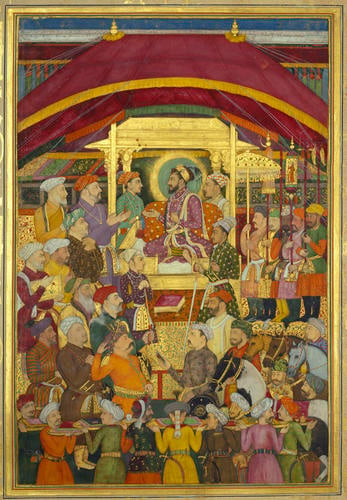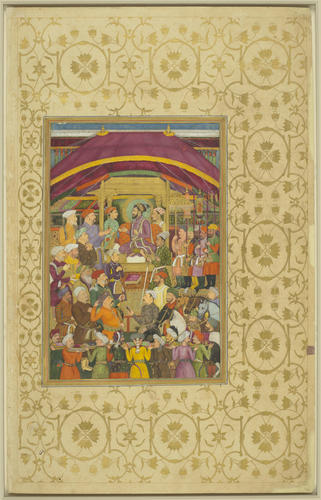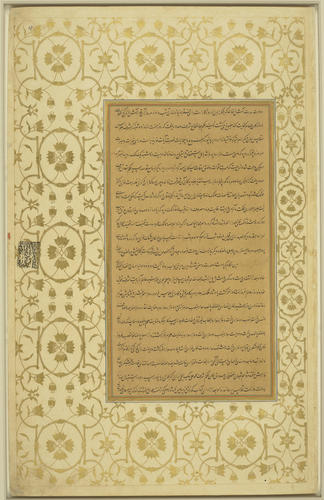Shah-Jahan receives the Persian ambassador, Muhammad-Ali Beg, during the New Year celebrations (March 1631) c. 1635 - 1650
Painting in opaque watercolour including metallic paints. | 30.7 x 20.4 cm (image) | RCIN 1005025.r

Attributed to Jalal Quli ('the Kashmiri Painter')
Master: Padshahnamah ?????????? (The Book of Emperors) ?? Item: Shah-Jahan receives the Persian ambassador, Muhammad-Ali Beg, during the New Year celebrations (March 1631) c. 1635 - 1650

Attributed to Jalal Quli ('the Kashmiri Painter')
Master: Padshahnamah پادشاهنامه (The Book of Emperors) Item: Shah-Jahan receives the Persian ambassador, Muhammad-Ali Beg, during the New Year celebrations (March 1631) c. 1635 - 1650



-
Padshahnamah fol. 98v
(plate 17)
Shah-Jahan receives the Persian ambassador, Muhammad-Ali Beg, during the Nawruz (New Year) celebrations at Burhanpur in March 1631.
Nawruz was an important ritualised festival involving gift-giving which was celebrated at the both the Mughal and Safavid Persian courts. At the time of the 1631 celebrations, an embassy from Shah Safi of Persia, the closest and most powerful of Shah-Jahan's rivals, had recently arrived at the Mughal court to congratulate the Emperor on his accession. The Persian ambassador, Muhammad-Ali Beg, appears dressed in orange near the bottom left of the painting and the Persian present bearers, recognisable by their distinctive turbans, are shown in a line at the bottom of the scene. The Persian mission remained attached to the Mughal court until the end of October 1632, and the ambassador also appears in another Padshahnamah painting of a court ceremony (RCIN 1005025.n).
Shah-Jahan’s court was based at Burhanpur in the Deccan at the time of the 1631 new year. The ceremony takes place under a tent with the wooden audience hall seen in the background. The Emperor sits on a gold throne with members of his family, his closest courtiers and imperial standard bearers standing around him on a gold embroidered carpet. The ambassador salutes the Emperor from outside a red railing before he is permitted entry to offer his New Year gifts of four horses and fine textiles.
The unsigned painting is attributed to Jalal Quli, also known as ‘the Kashmiri painter’. The varied quality and techniques used to paint different figures and details of the textiles may suggest that it is the work of more than one artist.
Bibliography:
Milo Beach and Ebba Koch, King of the world : the Padshahnama, an imperial Mughal manuscript from the Royal Library, Windsor Castle, 1996
Saqib Baburi, Beyond the Akbarnamah: Padshahnamahs and Official Regnal Chronography for Shah-Jahan Padshah (r. 1037/1628-1068/1658), 2010.Provenance
Illustration from a Padshahnamah manuscript formerly in the Mughal imperial library and acquired by Asaf al-Dawlah, Nawab of Awadh, c.1780-90; presented by Saadat Ali Khan, Nawab of Awadh, to George III via Lord Teignmouth in June 1799.
-
Creator(s)
Acquirer(s)
-
Medium and techniques
Painting in opaque watercolour including metallic paints.
Measurements
30.7 x 20.4 cm (image)
58.4 x 36.8 cm (page dimensions)
Category
Alternative title(s)
Shah-Jahan receives the Persian ambassador, Muhammad-Ali Beg (26 March 16







